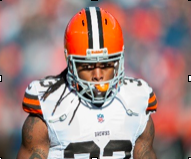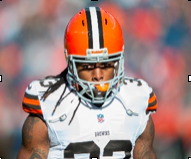By Ryan Wonsowicz
Just because you find yourself successful the first time around does not guarantee you’ll experience the same benefits during the second go around. This is true in life and, in this case, the National Football League. There is proof of the so called “sophomore slump” at any position, but I find the cases at the halfback position to be the most notable. Running backs are crucial to a team’s game plan and a surprising lack of production can drive coaches crazy. There are three players that I would like to talk about that have succumbed to this famous second year letdown.
Case 1: Trent Richardson 2013 NFL Season
 Before he was known as one of the greatest draft busts of all time, Richardson was the third overall pick back in 2012. The Browns loved everything about the Alabama product and Richardson showed that he was the real deal. He started 15 games, rushed for 950 yards, had 367 receiving yards, and found the end zone 12 times.
Before he was known as one of the greatest draft busts of all time, Richardson was the third overall pick back in 2012. The Browns loved everything about the Alabama product and Richardson showed that he was the real deal. He started 15 games, rushed for 950 yards, had 367 receiving yards, and found the end zone 12 times.
Expectations were high for Richardson entering year two. Through two games with Cleveland he had 105 yards on the ground. However, in a move that caught everyone off guard, Richardson was shipped to Indianapolis in Week 3. Richardson struggled heavily in his first year with the Colts, finishing with 458 yards on the ground and only three total touchdowns. He also ended the season with a weak 2.9 YPG.
Why Richardson struggled- The Browns cleared house after the 2012 season, so Richardson dealt with learning a second offense in as many seasons. The new Browns hierarchy had no faith in him, so he was dealt to Indianapolis to learn a third playbook. Richardson went from an offense that relied on a power run game to a West Coast scheme that featured Andrew Luck at quarterback. Instead of being handed the ball frequently, Richardson was used as a diversion in OC Pep Hamilton’s play action packages.
Case 2: Doug Martin, TB 2013 Season
 A relatively unknown coming out of Boise State, Martin exploded onto the scene in his rookie year. He ran wild with the ball, amassing 1,454 yards on the ground, as well as 472 from air. In addition, he finished with 12 total touchdowns and an absurd 90.9 YPG. Coming into 2013, everyone thought the
A relatively unknown coming out of Boise State, Martin exploded onto the scene in his rookie year. He ran wild with the ball, amassing 1,454 yards on the ground, as well as 472 from air. In addition, he finished with 12 total touchdowns and an absurd 90.9 YPG. Coming into 2013, everyone thought the
Pro Bowl running back would pick up right where he left off.
Instead, Martin face planted. He only made it through six games due to a torn labrum, but still managed just one rushing touchdown and 456 yards on 127 attempts. Also, his YPC decreased a whole yard, from 4.6 in 2012 to 3.6 in 2013.
Why Martin Struggled- His struggles in 2013 are still a head scratcher for me. He ran behind four of the five same offensive linemen from the year prior and worked with the same coaches. His season ended in Week 7, but, in the games he played, he wasn’t anywhere close to his rookie numbers. It’s possible he was destined to get injured thanks to a full year in OC Mike Sullivan’s run first approach. The Bucs tended to run the ball on first and second down, no matter the yardage. The QB controversy didn’t help either, as starter Josh Freeman was benched for weak-armed Mike Glennon in Week 4.
Case 3: Jeremy Hill, CIN 2015 Season
 The back from LSU was taken in the second round of the 2014 draft. He played second fiddle to Gio Bernard for the first half of the season until he exploded in Week 9 for 154 yards on the ground with two touchdowns. From that point on Hill was a freight train. In that time span, he rushed for an unfathomable 889 yards and finished with seven TDs. Coming into 2015, Hill was heralded as the next great back.
The back from LSU was taken in the second round of the 2014 draft. He played second fiddle to Gio Bernard for the first half of the season until he exploded in Week 9 for 154 yards on the ground with two touchdowns. From that point on Hill was a freight train. In that time span, he rushed for an unfathomable 889 yards and finished with seven TDs. Coming into 2015, Hill was heralded as the next great back.
Unfortunately, he fell way short of those aspirations. Despite recording 11 touchdowns, Hill ended with 794 rushing yards in the fifteen games he started. His YPG dropped to a meager 49.6 compared to 70.6 his first year. To top it off, his longest run of the season went for only 38 yards.
Why Hill Struggled- The Bengals took to the sky in 2015. Quarterback Andy Dalton had a career year and the offense finished just shy of 4000 passing yards which was 500 more than in 2014. Sharing a backfield with a prominent receiving back didn’t help Hill either. Bernard finished with 730 yards rushing(40% of the team’s total rushing yards) and 472 yards receiving. Also, Bernard was on the field for much longer, ending up playing 580 snaps compared to Hill’s 456.
Although the slump doesn’t strike every running back, it certainly is prominent around the NFL. Todd Gurley and David Johnson- consider yourselves warned.
*Statistics retrieved from Pro-Football-Reference.com and NFL.com
